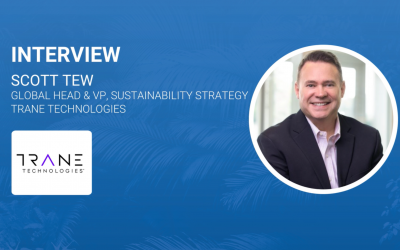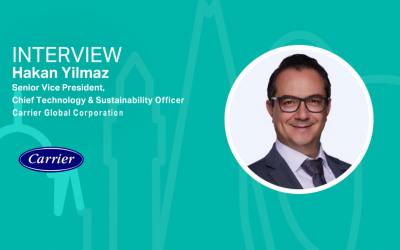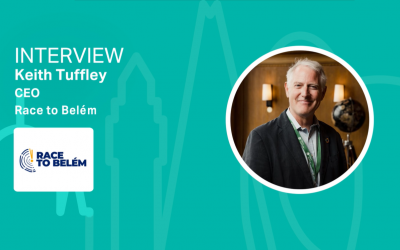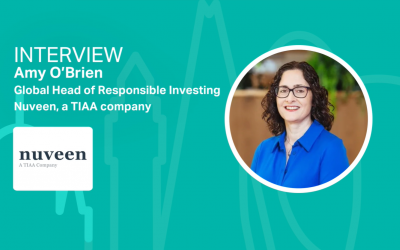Anurag Dayal, Blue Marble, on the importance of adopting a Green Circular Economy
Climate Action caught up with Anurag Dayal, Managing Director of BlueMarble GmbH, to discuss the importance of adopting a Green Circular Economy.

Climate Action caught up with Anurag Dayal, Managing Director of BlueMarble GmbH, to discuss the importance of adopting a Green Circular Economy.
Hi Anurag, it’s great to have you join us today.
For the benefit of our readers, you refer to the term “Green Circular Economy” how does this differ from the Circular Economy?
I will address this by two examples: I once visited the tea gardens of Ceylon and was invited for a evening tea in the estate managers home, a British colonial estate it was, The estate manager himself was ex-army and a very friendly person. He told me that, the estate on the hill on which we are sipping our teas is actiually full of Sapphires, the popular Ceylon Sapphires, and that they have to keep vigilance all the time to ensure no one is digging tunnels into it because the wealth is the tea which they grow on it every year. It provides three flushes every year and an economy on the back of it. This is a circular system, in fact all agriculture is a circular system where we grow plants and then use the seeds from the the same plant to grow them back and harvest them for creating and supporting an economy.
Another example is, I remember coca cola glass bottles earlier used to be returned to the factory for a price and they were refilled and brought back into circulation.
These are circular systems and circular models. The big difference being that the above examples are running on the back-bone of the fossils economy as all manufacturing, transportation, distribution, utilites etc are supported through it, and which is linear in nature. So a back-bone consisting of a linear model is supporting some circular processes as in the examples above.
A green circular economy would have the back-bone itself built on Green systems through Green technologies and that would make all other dependent and supported processes automatically green to that extent.
For economies to shift to a Green Circular Economy, what factors need to be aligned?
Technology here is not a factor as it already exists by large.
It is mainly the Governments resolve, strategies, policies, regulations, incentives etc. The International agencies like the UN, IEA, IPCC have done a massive and serious job in bringing about the awarness and focus and their roles will continue to remain central as global data would be required, assessed and shared in all sectors.
Further, today as we are shifting to a multilateral system at the same time, the coordination and cooperation between governments for the common cause is important. For example, the fossils industry was clearly divided between producers and consumers, the Green Circular economy will not have such constraints to a large extent and will allow everyone to take their own decisions and set their own targets but its levels of positive impact will depend upon how universally actions are being taken. Further, while some governments have done serious efforts to bring about awareness many others have not, including large economies.
Businesses and the private sector are the vehicles or tools for implementation and at the same time they are drivers for growth for all important spheres and they are knowledge centers also while forming the direct link to the consumers and workforces. That said, business have the responsibilities just the same as the subject here is a shared Climate and hence their initiatives to help and direct governments where required is crucial.
Finally, public awareness is fundamental as it allows an individual to take informed decisions and choices, thereby having a feedback effect which can be a forceful signal to the private sector.
Hence all the three forces form an equilateral triangle and they all need to be in alignment, but the Government is at the apex of the Triangle so its initiatives are the most important.
It’s commonly accepted that we need to move away from linear economic and business models but the shift has been evidently slow. In your experience, what are the major barriers we face and why do you think there is still a reluctance by governments to adopt or pursue green and circular economy principles?
I agree and believe that there are a number of very complex factors to this:
I will not hesitate to say that impedences are partly due to barriers created by the fossils lobbies in the first place. Governments in various countries have continued to protect fossils economies themselves.
It is only in the last couple of years when we have seen parties with green agenda coming to power and that too mainly in the European geographies and this is compounded with the fact that the EU block has had to deal with many issues resulting from the creation of the block in the recent years including events like Brexit. So globally a lot of energy is being spent on geopolitical issues; Russia, China India, Middle East and many others similarly have contributed adversly similarly in this regards.
Then further, anything new, and in this case we are talking in terms of global scale, many pros and cons need to be assessed and the benefits clearly highlighted as the impacts are profound. In this particular case we are talking about a comprehensive change starting from mindset to behaviour at mass scale apart from other things. If it was only about installing a piece of technological solution then things would have been simpler.
Finally, Any such process needs to be spearheaded, for example, what we know of digital technology today, it is because Microsoft and Apple spearheded them. And for such a complex process, spearheading starts from bringing together various and multiple processes, components and entities. How that will be achieved is yet to be addressed for a Green Circular Economy I guess.
Do you think COVID-19 might accelerate the shift towards more green and circular models as we seek to ‘build back better’ and more resilient economies and societies?
It should, is what I can say. COVID has clearly laid bare all vulnerabilites in black and white for all governments, companies and societies in general, and it is only sensible to understand that all need to ‘Build Back Better’. The weaknesses exposed should be accepted and addressed to achieve more resilient economies and societies. This is possible only if we change the model which has clearly shown us what its shortcomings are, and they are serious in nature and size. It is a matter of plain common sense not to repeat disasters and incoporate solutions timely. So I am hopeful that common sense will prevail.
You mentioned some key principles of a “Green Circular Economy” but what are the key technologies/innovations that will create these green systems?
The back bone as mentioned earlier can be successfully created with the help of Hydrogen. There are various methods to produce Hydrogen and quite interestingly there is one which creates a Green Circular Economy, and this is a full and complete economic model in real terms. The Fuel Cell of course is central to it. Further, I have set out how an innovation from the Solar sector can be used with the same to achieve even more effective results. Hence a Hydrogen based Green Circular Economy is possible and in fact I would be glad to share the details with those interested in helping establish such a model.
The other very important point here is, today there are various technologies which are considered Green; Wind, Solar, Batteries as some popular examples. Without going int to the details of their real impact, It needs to be noted that the back bone should not consist of patches of various technologies as it will lead to flexibility and stability issues apart from maintainnace, upgradation and costs related issues as a result. Any technology when it is uniform and universal in deployment will automatically lead to it becoming affordable and hence profitability will be directly impacted as well. The Hydrogen-based Green Circular Economy model addresses all such issues likewise.
You mentioned Hydrogen as a key element to the Green Circular Economy but there have been many “false starts” with this technology over the years. Why do you think now is the right time for Hydrogen, what has changed and could this be a ‘silver bullet’ technology?
Interesting point and it is true, I will address this from various dimensions
Many must have noted that a book when read again after a long pause can reveal new meanings and dimensions, some of the books I read as a teenager have revealed much more to me at my current age, surprisingly this includes the Britannica itself. So I think that the dimension of responsibility towards our Environment, Climate and Planet is revealed as never before today, and when we have read the book of our development through industralisation and from the data provided by todays science on the same.
Further and as such the understanding in many places existed during the past at least 50 years that fossils will prove to be a problem sooner or later, but the fossils advocates aggressively and successfully managed to suppress such instances and established an economy based on greed and selfishness arising from their own such qualities. Technology has helped address this area with hard evidences of the destructive impact of fossils on the Planet as global data became more accessible and science more capable. So the question about whether fossils are destructive or not is put to rest finally by science.
The population by large is an area which needs to understand that every litre of petrol they put in their climate controlled luxury vehicle as granted, is actually at the cost of literally butchering the Planet and turning its Climate and Environment into a total mess.
Further, what has the fossils based linear economy created and lead to, except for monetary wealth for a handful of people at the cost of well being of other people and the Planet as well?.
We need to have a clean, sustainable model which will help solve real problems which exist amongst us and which are clearly outlined in the 17 SDG’s and are the legacy of the fossils based linear economy. Every life on this planet is important, human or any other form and all of it depends on the same fundamental resources.
Hydrogen is used in the fuel cell for electricity and heat. It can be used to create a full and complete Green Circular Economy with some creative and technological enhances. It is no doubt the ‘Silver Bullet’ technology to address not just decarbonisation but to achieve the SDG’s as well.
But Hydrogen has been criticised for being extremely energy intensive to make. How can we make the production of Hydrogen more sustainable to fit within a Circular economy model?
One must keep in mind here that every litre of petrol starts from Oil exploration, onshore/offshore Drilling, Refining, Transportation, Storage, Distribution and then Consumption. And where each step is associated with serious environmental damage and energy consumption, but these costs are not added to it in that form, if added then the equation will be different for fossils. Hydrogen can be produced from a number of sources, Thermocracking of Oils, Algae, Electrolysing etc. None of them have been used at scales comparable to those as fossils are produced and used, thereby impacting the cost of Hydrogen production. Further, the economic model supported by Hydrogen is mainly free of environmental costs at its core and capable of achieving the 17 SDG’s successfully.
Also, innovations will play an important role, for example, there are innovations which will help reduce costs when electrolyzers are used and how they are used, similarly there are ideas addressing the Thermocracking of Oils which will lead to a circular economy.
Hydrogen has another benefit, a lot of the existing fossils infrastructure which is of very high capital expenditure can be used by it.
So any calculations should be made by keeping all these and such factors in mind.
Further in terms of costs, all new technologies are expensive as a rule, I bought my first mobile phone and it was an Ericsson which costed me 3000 usd in 1998, it did not have even half the functions which todays smartphones have. Scalability through universal adoption as mentioned earlier is the main solution.
Finally and most importantly, I would add here that any Hydrogen related technologies, if used only for the purpose of emissions reductions, risk resulting in a failure over time and will lead to the same situation as we are facing today with fossils in a lot of ways. The same technologies, if and when used to address the SDG’s will end up proving to be profitable and beneficial all around and in the long term as the benefits of all areas will get added for calculating profitability in monetary and non-monetary terms. So, how and for what a technology is used, is a fundamental question. For example, The cost of Hydrogen can be brought down if large amount of Electrolysers are installed just to produce Hydrogen, but doing this in such a format may bring down the cost for the purpose of bringing down the cost, but the real positive impact for which they should be used will not be served and them being the SDG’s. At the same time, when the same technologies will be used and deployed in a manner where the aim is the SDG’s, then we will be able to not only achieve emissions cuts, as they are only a subset of the SDG’s, but all other larger benefits as well, including cost benefits over time for all other related areas including Hydrogen itself.
I will add an insight here, Technology in itself is one thing and is mainly a function of Science, but how it should be used is another thing and this is a function of Creativity. So both faculties are needed to ensure that the most impactful solutions are derived. Does this remind of the left and right hemispheres?.
So what would a hydrogen-based Green Circular Economy model look like in reality? The European Union has just announced the European Hydrogen Alliance, do you think this will help organisations like BlueMarble accelerate a hydrogen-based Green Circular Economy model?
I will provide a description of the Green Circular Economy first:
Using the output of the first process as the input for the next process till the output of the last process in the system results in providing for the input of the first and the initiating process and hence forming a closed loop creates a Circular System. An economic model which uses such a system would be a Circular Economy, additionally, any system used for the purpose of eliminating or minimizing Linear consumption, Emissions and Waste would be a Green System. Hence when a Circular Economy is created with Green Systems, then it would essentially create a Green Circular Economy. The primary effect of which is in keeping the elements which enable it to run within the system, and such that Linear consumption, Emissions and Waste is eliminated or reduced to the minimum while serving and providing for the useful elements and thus rendering it Sustainable.
The establishing of such an economy which will be Hydrogen-based will involve the participation of a very large number of people from all sectors. Its implementation will be the largest ever project undertaken collectively. Considering everything is achieved successfully, the results will be felt by all through the positive impacts on the 17 SDG’s.
So here once again, one can consider the same exmaple of the Ceylon tea garden and where the linear back-bone is replaced with the circular back-bone.
It is encouraging to see the resolve and steps which the EU has taken on the topic of Climate and Hydrogen. However it is not clear as to whether the steps and resolve announced are only to address cuts in emissions or for the larger purpose of addressing the SDG’s also, as, if the SDG’s are to be addressed? then that is possible only through a Green Circular Economy and Hydrogen is the only viable candidate for the same.
As said previously, BlueMarble would be glad to engage with interested entities on the topic of establishing a Hydrogen-based Green Circular Economy as there are concrete solutions to consider for the purpose of the same with BlueMarble and which will enable us to ‘Build Back Better’.
You have emphasized on the SDG’s repeatedly, can you elaborate?
Let me start by asking what is the purpose of an economy?, for most individuals it is first about self preservation, meaning to secure food, shelter, clothing, education and health for themselves and their families, and then expanding into things like cars, holidays, hobbys etc. Is it possible that all of the 8 billion people on the planet have all of this through a linear model which only depletes all resources constantly, pollutes all around us, and devalues the money rapidly due to constant demand supply games. The linear model has given us what it was worth, and its worth is clearly defined in the 17 SDG’s. Any economy may or may not not be capable of serving to the expanded desires but should be capable of serving the fundamental needs successfully without destroying our environment. In fact all countries have problems which are fundamental and systemic in nature of some sort or another. Starting 2008 particularly, we have been experiencing the increased frequency of various crises relating to Economy, Climate, Health all over the world. These are all signals to understand the gravity of these 17 problems which are large enough to destroy our ownselves. Is that acceptable?. Or we need to wake up and say, yes we need to do better, we need to Build Back Better. Only a Green Circular Economy which has the characterisics of retaining value in the system and not depleting it, is capable of addressing such issues. So the correlation of the SDG’s to the Green Circular Economy is direct.
How can this affect Democracy as such?
Only for the better, the only threat to Democracy is a Bad Democracy and with the 17 SDG’s, we currently have a bad one. Common sense and timely action can get us out of this, all the more when the technology to achieve exists.






